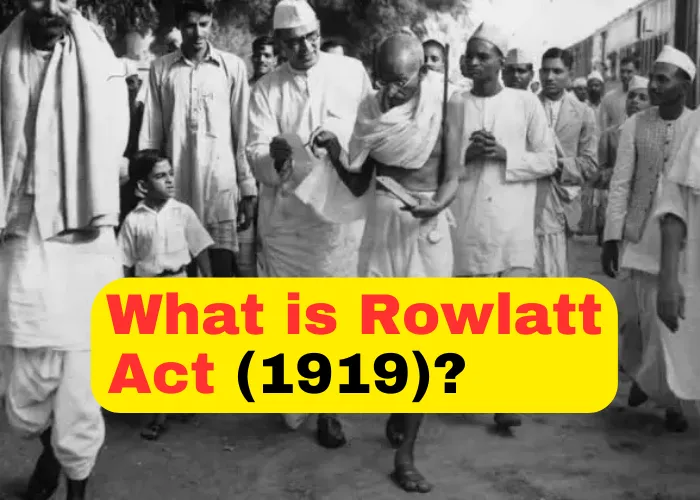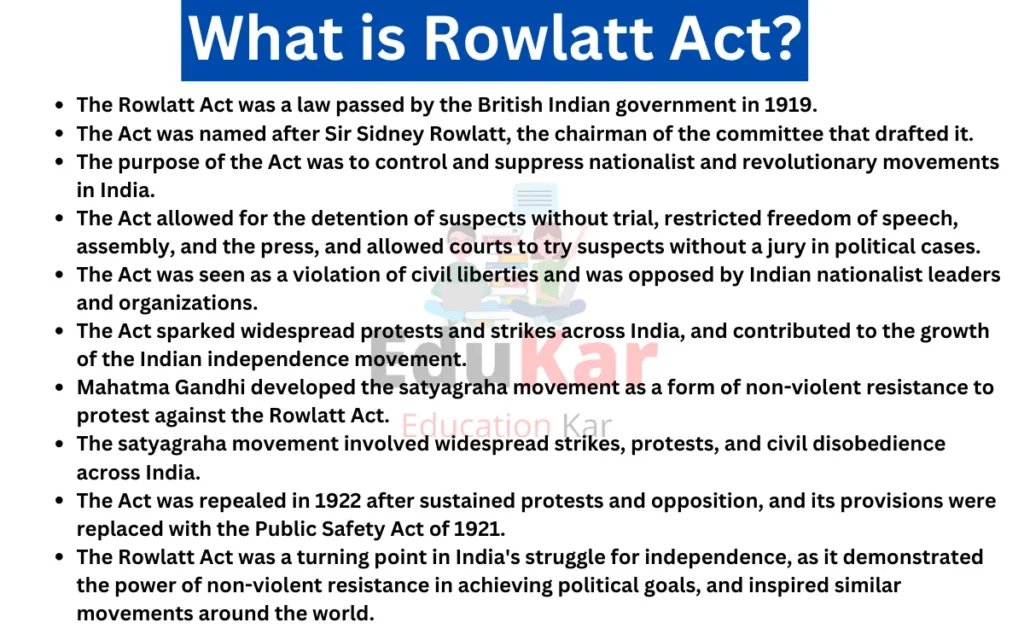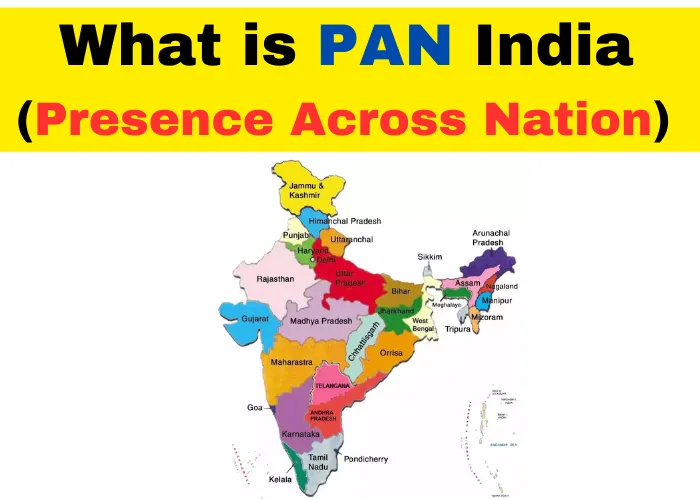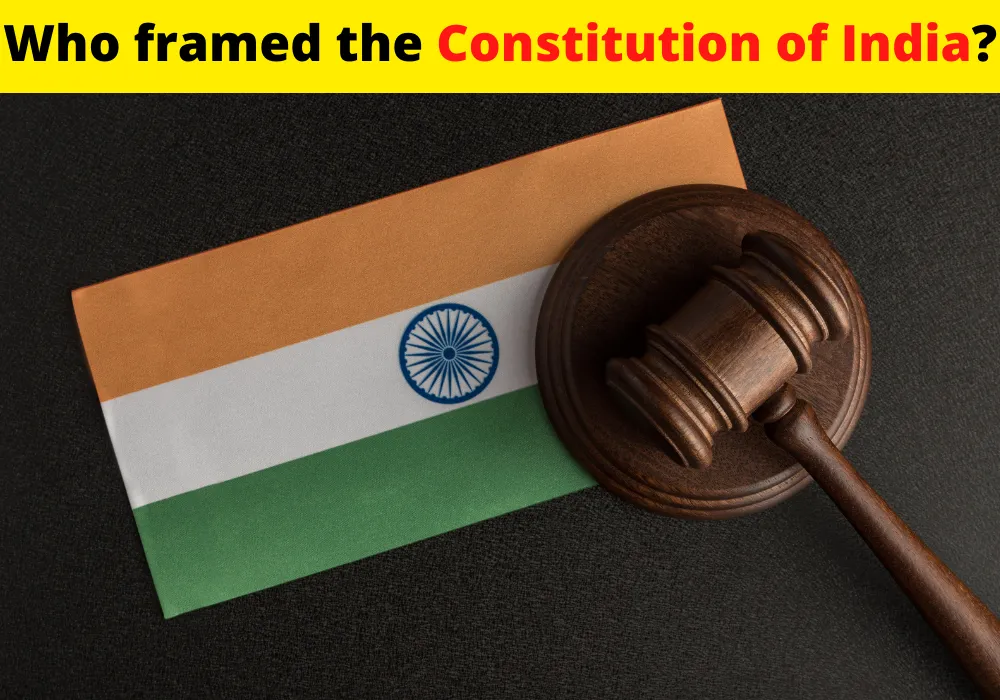Contents
- 1 Introduction
- 2 Who gave the idea of Rowlatt Act?
- 3 The Rowlatt Act’s Provisions
- 4 Effect of the Rowlatt Act on the citizens of British India
- 5 Satyagraha against the Rowlatt Act
- 6 How many killed in Jallianwala Bagh?
- 7 How did Rowlatt Act led to Jallianwala Bagh tragedy?
- 8 Conclusion
- 9 FAQs related to Rowlatt Act
The Rowlatt Act was a repressive law passed by the British Indian government in 1919. It gave the authorities sweeping powers to arrest and detain people without trial and to restrict civil liberties such as freedom of speech and assembly. This article provides an overview of the Rowlatt Act, including its key provisions, its impact on Indian society, and the protests and opposition it sparked.]

Introduction
The Rowlatt Act, also known as the Anarchical and Revolutionary Crimes Act of 1919, was a controversial law enacted by the British government in India. The act was a response to growing unrest and political agitation in India, particularly from Indian nationalists who were demanding greater autonomy and self-rule.
| Fact | Detail |
|---|---|
| Name of the Act | The Rowlatt Act |
| Year of enactment | 1919 |
| Place of enactment | Amritsar, Jallianwalla Bagh (British India) |
| Purpose of the Act | To control and suppress nationalist and revolutionary movements in India. |
| Key provisions of the Act | Allowed detention of suspects without trial. Restricted freedom of speech, assembly, and the press. Allowed courts to try suspects without a jury in political cases. |
| Criticism of the Act | Was seen as a violation of civil liberties. Was seen as a discriminatory law against Indians. Was opposed by Indian nationalist leaders and organizations. |
| Protests against the Act | Sparked protests and strikes across India Led to the Jallianwala Bagh massacre in Amritsar Contributed to the growth of the Indian independence movement |
| Repeal of the Act | The Act was repealed in 1922 after sustained protests and opposition. Its provisions were replaced with the Public Safety Act of 1921 |

Who gave the idea of Rowlatt Act?
The idea for the Rowlatt Act was proposed by Sir Sidney Rowlatt, a British judge who was appointed to investigate the situation in India and make recommendations to the government. The Rowlatt Act was based on the recommendations made by Rowlatt in his report, which identified a perceived threat of political unrest and violence in India and recommended that the government be given more power to suppress political dissent and prevent rebellion.
The Rowlatt Act’s Provisions
The Rowlatt Act, also known as the Anarchical and Revolutionary Crimes Act of 1919, was a law passed by the British government in India during the colonial era. It was enacted in response to growing political unrest and violence in the country, and was designed to give the government greater powers to suppress political dissent and prevent rebellion.
The key provisions of the Rowlatt Act included:
1. Detention without trial
The act gave the government the power to detain individuals without trial for up to two years if they were suspected of committing crimes related to political dissent or rebellion. This provision was considered a major infringement on civil liberties, as it allowed the government to detain individuals without providing them with a fair trial or an opportunity to defend themselves.
2. Restrictions on freedom of assembly
The act gave the government the power to prohibit public meetings and assemblies, and to arrest and detain individuals who participated in such gatherings. This provision was seen as a major violation of the right to free speech and peaceful assembly.
3. Restrictions on freedom of the press
The act gave the government the power to prohibit or censor publications that were deemed to be seditious or dangerous to public order. This provision was considered a major infringement on the freedom of the press and the right to access information.
4. Expanded powers for law enforcement
The act gave the government and the police greater powers to investigate and prosecute crimes related to political dissent and rebellion. This included the power to conduct searches without warrants and to use force if necessary to maintain public order.
The Rowlatt Act was met with widespread opposition and civil disobedience in India, and was seen as a major violation of civil liberties and human rights. The act ultimately contributed to the growing discontent and opposition to British rule in India, and played a significant role in the Indian independence movement. It was eventually repealed in 1922, after sustained protests and civil unrest.
Effect of the Rowlatt Act on the citizens of British India
The Rowlatt Act, also known as the Anarchical and Revolutionary Crimes Act of 1919, had a significant impact on the citizens of British India. The act gave the British government broad powers to suppress political dissent and prevent rebellion, which led to a number of negative effects on Indian society.
One of the most immediate effects of the Rowlatt Act was the restriction of civil liberties. The act allowed the government to detain individuals without trial for up to two years, and it also restricted freedom of the press and assembly. This meant that the Indian people had little to no ability to speak out against the British government or organize themselves for political change.
The act created an atmosphere of fear and suspicion among the Indian people. They were constantly under surveillance and any form of political dissent was met with harsh punishment. This led to a sense of hopelessness and a feeling that there was no way to change their situation.
The Rowlatt Act also led to a wave of protests and civil disobedience across India. The Indian National Congress, which was the main political party in India at the time, strongly opposed the act and organized a mass protest on April 6, 1919, which was observed as a “Black Day” by the Indian public. The non-cooperation movement, led by Mahatma Gandhi, was also launched in response to the Rowlatt Act. This movement called for nonviolent resistance against British rule and was one of the largest civil disobedience campaigns in Indian history.
Despite the peaceful nature of the non-cooperation movement, it was met with violent repression by the British government. The most infamous incident was the Jallianwala Bagh massacre, which occurred on April 13, 1919, in Amritsar. British troops fired on a crowd of unarmed protesters, killing hundreds of people and injuring many more. This incident further galvanized the Indian independence movement and fueled anti-British sentiment.
Satyagraha against the Rowlatt Act
Satyagraha was a form of non-violent resistance developed by Mahatma Gandhi that was used to protest against the Rowlatt Act in 1919. Satyagraha is a combination of the Sanskrit words “satya” meaning truth and “agraha” meaning insistence or holding firmly to something.
Gandhi called for a nationwide strike and protest against the Rowlatt Act, and he used satyagraha to mobilize Indian people to resist the British colonial government. He urged Indians to refuse to pay taxes, boycott British goods, and engage in peaceful protests and civil disobedience.
The satyagraha movement gained momentum and resulted in widespread strikes, protests, and civil disobedience across India. Gandhi and other Indian leaders were arrested, but this only further fueled the movement.
The satyagraha campaign against the Rowlatt Act was a turning point in India’s struggle for independence, as it demonstrated the power of non-violent resistance in achieving political goals. It paved the way for the larger independence movement and inspired similar movements around the world.
How many killed in Jallianwala Bagh?
On April 13, 1919, British troops fired on a crowd of unarmed Indian protesters gathered in Jallianwala Bagh, a public garden in Amritsar, Punjab. The number of people killed or injured in the incident is not clear, but it is estimated that hundreds of people were killed and more than a thousand were injured.
The exact number of casualties is disputed, as the British Raj authorities did not release an official figure. However, based on various estimates and historical accounts, it is generally believed that at least 379 people were killed and over a thousand were injured in the massacre.
How did Rowlatt Act led to Jallianwala Bagh tragedy?
The Rowlatt Act was strongly opposed by Indian nationalist leaders such as Mahatma Gandhi and the Indian National Congress. They called for a nationwide strike and protests to demonstrate their opposition to the Act.
In Amritsar, Punjab, a large number of people gathered in the Jallianwala Bagh public garden on April 13, 1919 to protest against the Rowlatt Act and to demand the release of two Indian leaders who had been arrested. The gathering was peaceful and included men, women, and children.
However, the British colonial authorities, who were alarmed by the growing protests, ordered the British Indian Army to open fire on the unarmed crowd without any warning or provocation. The soldiers, under the command of General Reginald Dyer, fired on the crowd for about ten minutes, killing and injuring hundreds of people.
The Jallianwala Bagh massacre was a direct result of the repressive measures of the Rowlatt Act and the British government’s failure to address the grievances of the Indian people. It had a profound impact on Indian politics and contributed to the growth of the Indian independence movement.
Conclusion
The Rowlatt Act was a highly controversial law that had a profound impact on Indian society. Its provisions were met with widespread opposition, and it led to a wave of protests and civil disobedience. The act was eventually repealed, but its legacy lives on in the history of India’s struggle for independence. The Rowlatt Act remains an important reminder of the importance of civil liberties and human rights, and it continues to be a source of inspiration for those fighting against oppression and injustice around the world.
What is the Rowlatt Act?
The Rowlatt Act was a law passed by the British Indian government in 1919 that gave the authorities extensive powers to arrest and detain people without trial and to restrict civil liberties such as freedom of speech and assembly.
Why was the Rowlatt Act passed?
The Rowlatt Act was passed as a response to the growing nationalist and revolutionary movements in India. The British colonial authorities saw these movements as a threat to their rule and sought to suppress them.
What were the key provisions of the Rowlatt Act?
The key provisions of the Rowlatt Act included the power to arrest and detain suspects without trial, the ability to try suspects without a jury in political cases, and the restriction of civil liberties such as freedom of speech, assembly, and the press.
Why was the Rowlatt Act criticized?
The Rowlatt Act was criticized for being a violation of civil liberties and for being a discriminatory law against Indians. Indian nationalist leaders and organizations opposed the Act and called for its repeal.
What was the satyagraha campaign against the Rowlatt Act?
The satyagraha campaign was a non-violent resistance movement developed by Mahatma Gandhi to protest against the Rowlatt Act. The movement involved widespread strikes, protests, and civil disobedience across India.
What was the impact of the Rowlatt Act on Indian society?
The Rowlatt Act had a profound impact on Indian society, as it contributed to the growth of the Indian independence movement and demonstrated the power of non-violent resistance in achieving political goals. It also led to widespread protests and strikes across India and contributed to the decline of British colonial rule.




![Corporate Accounting [Important Questions & Answers with MCQ] Corporate Accounting Important Questions & Answers](https://edukar.in/wp-content/uploads/2022/09/Corporate-Accounting-Important-Questions-Answers-1024x597.webp)
![Zoology Important Questions [Class 11th-English medium] Zoology Important Questions class 10 english medium](https://edukar.in/wp-content/uploads/2022/09/Zoology-Important-Questions-class-10-english-medium-1024x597.webp)


![Biology Class 10 Very important [Questions &Answers] Biology Important Questions with Answers class 10](https://edukar.in/wp-content/uploads/2022/09/Biology-Important-Questions-with-Answers-class-10-1024x597.webp)

![Web application and Security Class 10 [Questions Answers & MCQs] Web application Class 10 Questions & Answers](https://edukar.in/wp-content/uploads/2022/09/Web-application-Class-10-Questions-Answers-1024x597.webp)

![Digital Documentation Class 9 [Questions Answers & MCQ] Digital Documentation Class 9](https://edukar.in/wp-content/uploads/2022/08/Digital-Documentation-Class-9-1024x597.webp)



